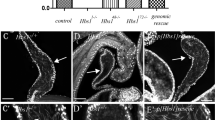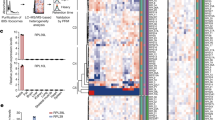Abstract
During the process of spermatogenesis, the proliferation of spermatogonia (stem cell descendants) is replaced by their differentiation in growing spermatocytes responsible for the preparation to meiosis, which is accompanied by a cardinal change in transcriptional programs. We have demonstrated that, in drosophila, this process is accompanied by a splash of the expression of β-subunit of nascent polypeptide-associated complex (NAC) associated by ribosomes. Nascent polypeptide-associated complex is known as a chaperone involved in co-translational protein folding. This is the first case of the detection of tissue-specific co-translational NAC cofactor in multicellular eukaryotes. It is proposed that spermatocyte specific NAC is involved in the modulation of the expression of the proteins that provide the functioning of subsequent stages of spermatogenesis.
Similar content being viewed by others
References
Wiedmann B., Sakai H., Davis T.A., Wiedmann M. 1994. A protein complex required for signal-sequencespecific sorting and translocation. Nature. 370 (6489), 434–440.
Rospert S., Dubaquie Y., Gautschi M. 2002. Nascentpolypeptide- associated complex. Cell. Mol. Life Sci. 59 (10), 1632–1639.
Pechmann S., Willmund F., Frydman J. 2013. The ribosome as a hub for protein quality control. Mol. Cell. 49 (3), 411–421.
Deng J.M., Behringer R.R. 1995. An insertional mutation in the BTF3 transcription factor gene leads to an early postimplantation lethality in mice. Transgenic Res. 4 (4), 264–269.
Markesich D.C., Gajewski K.M., Nazimiec M.E., Beckingham K. 2000. Bicaudal encodes the Drosophila beta NAC homolog, a component of the ribosomal translational machinery. Development. 127 (3), 559–572.
Bloss T.A., Witze E.S., Rothman J.H. 2003. Suppression of CED-3-independent apoptosis by mitochondrial betaNAC in Caenorhabditis elegans. Nature. 424 (6952), 1066–1071.
Del Alamo M., Hogan D.J., Pechmann S., Albanese V., Brown P.O., Frydman J. 2011. Defining the specificity of cotranslationally acting chaperones by systematic analysis of mRNAs associated with ribosome-nascent chain complexes. PLoS Biol. 9 (7), e1001100.
Lesnik C., Cohen Y., Atir-Lande A., Schuldiner M., Arava Y. 2014. OM14 is a mitochondrial receptor for cytosolic ribosomes that supports co-translational import into mitochondria. Nat. Commun. 5, 5711.
Guo B., Huang J., Wu W., Feng D., Wang X., Chen Y., Zhang H. 2014. The nascent polypeptide-associated complex is essential for autophagic flux. Autophagy. 10 (10), 1738–1748.
Creagh E.M., Brumatti G., Sheridan C., Duriez P.J., Taylor R.C., Cullen S.P., Adrain C., Martin S.J. 2009. Bicaudal is a conserved substrate for Drosophila and mammalian caspases and is essential for cell survival. PLoS ONE. 4 (3), e5055.
Arsenovic P.T., Maldonado A.T., Colleluori V.D., Bloss T.A. 2012. Depletion of the C. elegans NAC engages the unfolded protein response, resulting in increased chaperone expression and apoptosis. PLoS ONE. 7 (9), e44038.
Karan R., Subudhi P.K. 2012. Overexpression of a nascent polypeptide associated complex gene (Sabeta- NAC) of Spartina alterniflora improves tolerance to salinity and drought in transgenic Arabidopsis. Biochem. Biophys. Res. Commun. 424 (4), 747–752.
Kirstein-Miles J., Scior A., Deuerling E., Morimoto R.I. 2013. The nascent polypeptide-associated complex is a key regulator of proteostasis. EMBO J. 32 (10), 1451–1468.
Hotokezaka Y., Katayama I., Van Leyen K., Nakamura T. 2015. GSK-3beta-dependent downregulation of gammataxilin and alphaNAC merge to regulate ER stress responses. Cell Death Dis. 6, e1719.
Gamerdinger M., Hanebuth M.A., Frickey T., Deuerling E. 2015. The principle of antagonism ensures pro-tein targeting specificity at the endoplasmic reticulum. Science. 348 (6231), 201–207.
Nyathi Y., Pool M.R. 2015. Analysis of the interplay of protein biogenesis factors at the ribosome exit site reveals new role for NAC. J. Cell. Biol. 210 (2), 287–301.
Usakin L.A., Kogan G.L., Kalmykova A.I., Gvozdev V.A. 2005. An alien promoter capture as a primary step of the evolution of testes-expressed repeats in the Drosophila melanogaster genome. Mol. Biol. Evol. 22 (7), 1555–1560.
Kogan G.L., Usakin L.A., Ryazansky S.S., Gvozdev V.A. 2012. Expansion and evolution of the X-linked testis specific multigene families in the melanogaster species subgroup. PLoS ONE. 7 (5), e37738.
Usakin L.A., Gvozdev V.A., Kogan L.L. 2009. Molecular variation of the testes-specific ßNACtes genes in the Drosophila melanogaster genome. Mol. Biol. (Moscow). 43 (3), 367–373.
Vibranovski M.D., Lopes H.F., Karr T.L., Long M. 2009. Stage-specific expression profiling of Drosophila spermatogenesis suggests that meiotic sex chromosome inactivation drives genomic relocation of testisexpressed genes. PLoS Genet. 5 (11), e1000731.
Chen X., Lu C., Morillo Prado J.R., Eun S.H., Fuller M.T. 2011. Sequential changes at differentiation gene promoters as they become active in a stem cell lineage. Development. 138 (12), 2441–2450.
White-Cooper H. 2010. Molecular mechanisms of gene regulation during Drosophila spermatogenesis. Reproduction. 139 (1), 11–21.
Barreau C., Benson E., Gudmannsdottir E., Newton F., White-Cooper H. 2008. Post-meiotic transcription in Drosophila testes. Development. 135 (11), 1897–1902.
Blumer N., Schreiter K., Hempel L., Santel A., Hollmann M., Schafer M.A., Renkawitz-Pohl R. 2002. A new translational repression element and unusual transcriptional control regulate expression of don juan during Drosophila spermatogenesis. Mech. Dev. 110 (1–2), 97–112.
Gilbert W.V. 2011. Functional specialization of ribosomes? Trends Biochem. Sci. 36 (3), 127–132.
Shi Z., Barna M. 2015. Translating the genome in time and space: Specialized ribosomes, RNA regulons, and RNA-binding proteins. Annu. Rev. Cell Dev. Biol. 31, 31–54.
Kibanov M.V., Kotov A.A., Olenina L.V. 2013. Multicolor fluorescence imaging of whole-mount Drosophila testes for studying spermatogenesis. Anal. Biochem. 436(1), 55–64.
Xing Y., Li W.X. 2015. Heterochromatin components in germline stem cell maintenance. Sci. Rep. 5, 17463.
Ott A.K., Locher L., Koch M., Deuerling E. 2015. Functional dissection of the nascent polypeptide-associated complex in Saccharomyces cerevisiae. PLoS ONE. 10 (11), e0143457.
Sanchez C.G., Teixeira F.K., Czech B., Preall J.B., Zamparini A.L., Seifert J.R., Malone C.D., Hannon G.J., Lehmann R. 2016. Regulation of ribosome biogenesis and protein synthesis controls germline stem cell differentiation. Cell Stem Cell. 18 (2), 276–290.
Kondrashov N., Pusic A., Stumpf C.R., Shimizu K., Hsieh A.C., Xue S., Ishijima J., Shiroishi T., Barna M. 2011. Ribosome-mediated specificity in Hox mRNA translation and vertebrate tissue patterning. Cell. 145 (3), 383–397.
Author information
Authors and Affiliations
Corresponding author
Additional information
Original Russian Text © G.L. Kogan, N.V. Akulenko, Yu.A. Abramov, O.A. Sokolova, E.A. Fefelova, V.A. Gvozdev, 2017, published in Molekulyarnaya Biologiya, 2017, Vol. 51, No. 4, pp. 677–682.
Rights and permissions
About this article
Cite this article
Kogan, G.L., Akulenko, N.V., Abramov, Y.A. et al. Nascent polypeptide-associated complex as tissue-specific cofactor during germinal cell differentiation in Drosophila testes. Mol Biol 51, 596–601 (2017). https://doi.org/10.1134/S0026893317040112
Received:
Accepted:
Published:
Issue Date:
DOI: https://doi.org/10.1134/S0026893317040112




